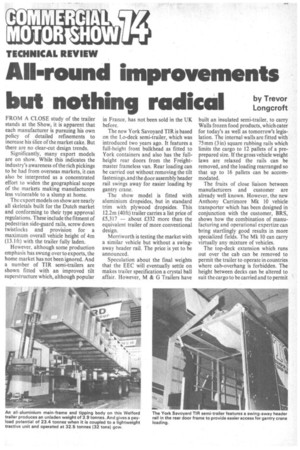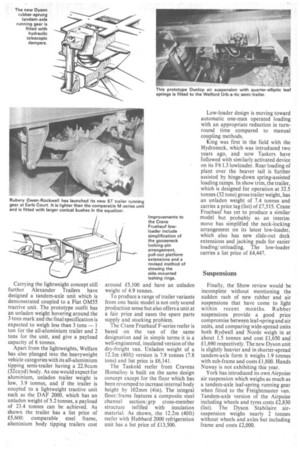All-round improvements
Page 61

Page 63

If you've noticed an error in this article please click here to report it so we can fix it.
but nothing radicalby Tregcroftvor
Lon
FROM A CLOSE study of the trailer stands at the Show, it is apparent that each manufacturer is pursuing his own policy of detailed refinements to increase his Slice of the market cake. But there are no clear-cut design trends.
Significantly, many export models are on show. While this indicates the industry's awareness of the rich pickings to be had from overseas markets, it can also be interpreted as a concentrated effort to widen the geographical scope of the markets making manufacturers less vulnerable to a slump at home.
The export models on show are nearly all skeletals built for the Dutch market and conforming to their type approval regulations. These include the fitment of pedestrian side-guard rails, screw down twistlocks and provision for a maximum overall vehicle height of 4m (13.1ft) with the trailer fully laden.
However, although some production emphasis has swung over to exports, the home market has not been ignored. And a number of TIR semi-trailers are shown fitted with an improved tilt superstructure which, although popular in France. has not been sold in the UK before.
The new York Savoyard TIR is based on the Lo-deck semi-trailer, which was introduced two years ago. It features a full-height front bulkhead as fitted to York containers and also has the fullheight rear doors from the Freightmaster frameless van. Rear loading can be carried out without removing the tilt fastenings, and the door assembly header rail swings away for easier loading by gantry crane.
The show model is fitted with aluminium dropsides, but in standard trim with plywood dropsides. This 12.2m (40ft) trailer carries a list price of 0,317 — about £.332 more than the equivalent trailer of more conventional design.
Merriworth is testing the market with a similar vehicle but without a swingaway header rail. The price is yet to be announced.
Speculation about the final weights that the EEC will eventually settle on makes trailer specification a crystal ball affair. However, M & G Trailers have built an insulated semi-trailer, to carry Walls frozen food products, which cater for today's as well as tomorrow's legislation. The internal walls are fitted with 75 mm (3 in) square rubbing rails which limits the cargo to 12 'pallets of a preprepared size. If the gross vehicle weight laws are relaxed the rails can be removed, and the loading rearranged so that up to 16 pallets can be accommodated.
The fruits of close liaison between manufacturers and customer are already well known. However, the new Anthony Carrimore Mk 10 vehicle transporter which has been designed in conjunction with the customer, BRS, shows how the combination of manufacturing and operational expertize can bring startlingly good results in more specialized fields. The Mk 10 can carry virtually any mixture of vehicles.
The top-deck extension which runs out over the cab can be removed to permit the trailer to operate in countries where cab-overhang is forbidden. The height between decks can be altered to suit the cargo to be carried and to permit Carrying the lightweight concept still further Alexander Trailers have designed a tandem-axle unit which is demonstrated coupled to a Fiat 0M55 tractive unit. The prototype outfit has an unladen weight hovering around the 3 tons mark and the final specification is expected to weigh less than 3 tons — 1 ton for the all-aluminium trailer and 2 tons for the unit, and give a payload capacity of 6 tonnes.
Apart from the lightweights, Welfare has also plunged into the heavyweight vehicle categories with its all-aluminium tipping semi-trailer having a 22.9 cum (32cuyd) body. As one would expect for aluminium, unladen trailer weight is low, 3.9 tonnes, and if the trailer is coupled to a lightweight tractive unit such as the DAF 2000, which has an unladen weight of 5.2 tonnes, a payload of 23.4 tonnes can be achieved. As shown the trailer has a list price of £5,600: comparable steel frame, aluminium body tipping trailers cost around £5,100 and have an unladen weight of 4.9 tonnes.
To produce a range of trailer variants from one basic model is not only sound production sense but also offers a unit at a fair price and eases the spare parts supply and stocking problem.
The Crane Fruehauf F-series reefer is based on the van of the same designation and in simple terms it is a well-engineered, insulated version of the dry-freight van. Unladen weight of a 12.2m (40ft) version is 7.9 tonnes (7.8 tons) and list price is £6,141.
The Taskold reefer from Cravens Homalloy is built on the same design concept except for the floor which has been revamped to increase internal body height by 102mm (4in). The integral floor/ frame features a composite steel channel section/ grp cross-member structure infilled with insulation material. As shown, the 12.2m (40ft) reefer with Hubbard 2000 refrigeration unit has a list price of £13,500. Low-loader design is moving toward automatic one-man operated loading with an appropriate reduction in turnround time compared to manual coupling methods.
King was first in the field with the Hydroneck, which was introduced two years ago, and now Taskers have followed with similarly activated device on its F6 L3 lowloader. Rear loading of plant over the beaver tail is further assisted by hinge-down spring-assisted loading ramps. In show trim, the trailer, which is designed for operation at 32.5 tonnes (32 tons) gross trailer weight, has an unladen weight of 7.4 tonnes and carries a price tag (list) of £7,515. Crane Fruehauf has yet to produce a similar model but probably as an interim move has simplified the neck-locking arrangement on its latest low-loader, which also, has new slide-out deck extensions and jacking pads for easier loading/ unloading. The low-loader carries a list price of £4,447.
Suspensions
Finally, the Show review would be incomplete without mentioning the sudden rash of new rubber and air suspensions that have come to light within recent months. Rubber suspensions provide a good price compromise between leaf-spring and air units, and comparing wide-spread units both Rydwell and Norde weigh in at about 1.5 tonnes and cost £1,650 and £1,690 respectively. The new Dyson unit is slightly heavier and in shorter-spread tandem-axle form it weighs 1.9 tonnes with sub-frame and costs £1,800. Hands Nuway is not exhibiting this year.
York has introduced its own Airpoise air suspension which weighs as much as a tandem-axle leaf-spring running gear when fitted to the Freightmaster van. Tandem-axle version of the Airpoise including wheels and tyres costs £2,830 (list). The Dyson Stabilaire airsuspension weighs nearly 2 tonnes without wheels and axles but including frame and costs £2,000.




























































































































































